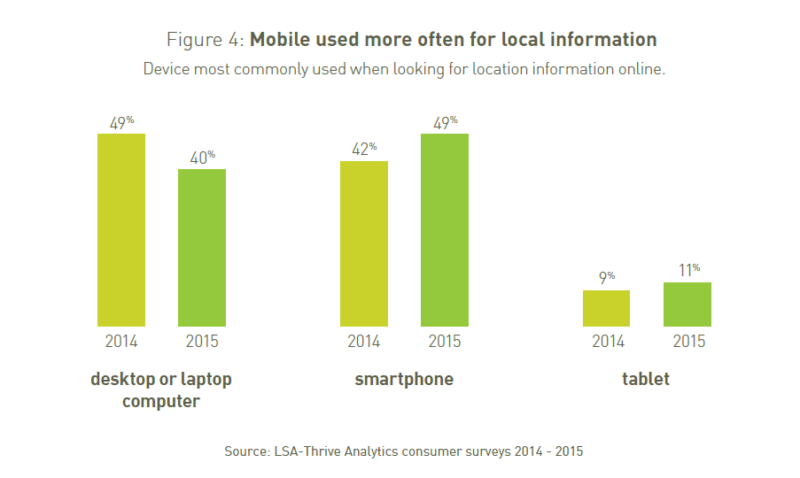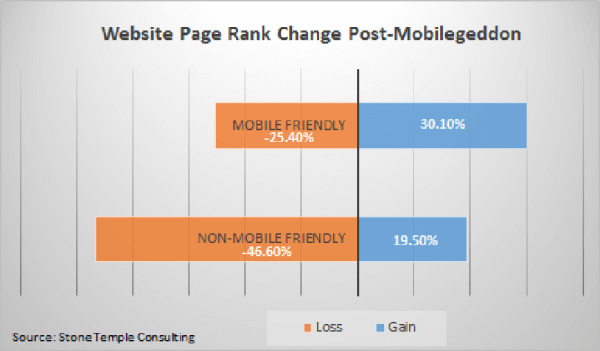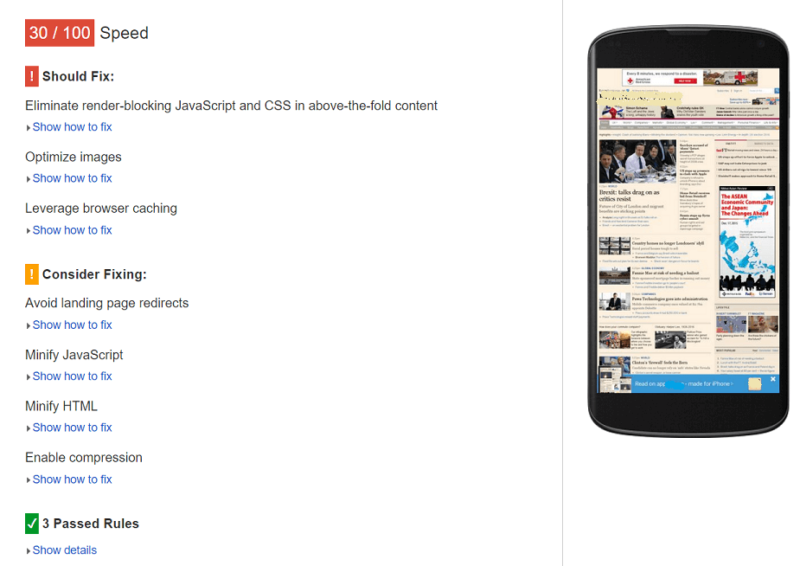The Need For Speed: 7 Observations On The Impact Of Page Speed To The Future Of Local Mobile Search – Search Engine Land
sel logo
Search Engine Land » Platforms » Meta » Facebook » The Need For Speed: 7 Observations On The Impact Of Page Speed To The Future Of Local Mobile Search
SearchBot requires a free Search Engine Land account to use, and gives you access to all SearchBot personas, an image generator, and much more!
If you already have a Search Engine Land account, log in now. Otherwise, register here!

Having a mobile website in and of itself sets an SMB apart from almost half of its competitors. The Local Search Association (LSA) issued a report commissioned by BuzzBoard titled “Mobile: Ready — or Not?” in January 2016.
BuzzBoard’s research found that 47.3 percent of SMBs do not have mobile-ready sites. The report also notes another 2015 study by RBC Capital Markets that reflects an even lower rate of adoption — it found 67 percent of SMBs’ sites are not mobile-ready.
Those with mobile websites arguably stand to double the audience of those without mobile sites. According to comScore’s “Global Mobile Report,” virtually half of all traffic to the top 100 digital media properties are mobile only.
The LSA and BuzzBoard report notes that in October 2015, Google stated that over 50 percent of search globally is on mobile. And surveys by LSA and Thrive Analytics reflect that mobile is even more important for local search — 60 percent said they usually use a mobile device (smartphone or tablet) when looking for local information online.

The problem for those without a mobile site is twofold. First, consumers demand it. Google reports that 57 percent of users won’t recommend a business with a poorly designed mobile site, and 40 percent go to a competitor after a bad mobile experience.
Second, you’ll get fewer visits with a non-mobile site. Three months after Google launched its new algorithm last year that penalized the mobile search rank of web pages that were not optimized, almost half of non-mobile-friendly web pages experienced a loss in page rank.

Yet Google is constantly tweaking and updating its algorithm. So what’s next? How can savvy SMBs stay ahead and maintain their competitive advantage? One area to review is the speed of your mobile website. This is an area Google is taking an increasingly closer look at, especially with the launch of its new Accelerated Mobile Pages (AMP), discussed in more detail below.
Below are seven observations and tips about the importance to a local business of its mobile website’s speed and how to outpace your competitors by maintaining a positive and responsive user experience.
Consumers don’t just want mobile websites, they want fast mobile websites. Consumer attention spans are growing shorter. Consumers abandon websites if they take too long to load, with 40 percent abandoning a site if it takes more than three seconds to load.
And their patience with mobile sites is even less than that for sites accessed via a desktop. Yet the median load time for the top 100 retail mobile sites was 4.33 seconds, as measured in 2013 by Radware, increasing to 4.8 seconds in 2014.
That 1+ second might not seem like much, but slow pages was the number one user complaint about mobile sites. According to Radware’s 2014 State of the Union for Mobile eCommerce Performance, every one-second delay impacts bounce rate, conversion rate, cart size and page views.

Early reports stated that page load speed did not affect page rank on mobile websites as part of Google’s Mobilegeddon. Yet, anecdotally, observations about Mobilegeddon seem to contradict those reports.
Based on an analysis of client sites, Colin Guidi, director of SEO at 3Q Digital, said, “Visiting these sites via a mobile browser and slower processors shows that page speed and load time seems to be a heavier weighted ranking factor over this new mobile-friendly update.”
Studies also appear to support those observations. Searchmetrics released a report post-Mobilegeddon that demonstrated a strong correlation between page speed and page rank.
And now, Google itself has come out this year stating that Google favors faster sites. Further, David Besbris, AP Engineering of Google Search, asserted on the AMP Project page that “Speed has always been a cornerstone of Google Search.”
I think it’s safe to operate under the presumption that speed matters when it comes to local mobile search.
Google wants to maintain its market share in search by making sure that consumers like their user experience with sites pulled up in its search results.
Since consumers want a fast web experience, Google is pushing websites to make sure they meet those expectations, and it has set the bar high. Google’s standard is for mobile web pages to render in less than one second on a mobile network. One second is an extremely high standard when you consider, per above, most retail mobile websites mobile take more than four seconds to load.
It might also seem unfair given the number of factors that website operators do not have control over, such as the user’s network speed. Nevertheless, Google offers a PageSpeed Insight tool to measure a website’s performance and provide tips on improving poor scoring areas.
The illustration below is an analysis from that Google PageSpeed tool of a website that scored poorly. It provides both recommended and suggested fixes that would help speed up the site.

Google is competing to keep users on the mobile web when they are increasingly spending time on apps. Platforms like Facebook and Snapchat are developing more ways to consume content within their apps and are providing a slick user experience to take user time away from the web, where Google dominates.
Facebook isn’t even trying to be discreet about its goal for Instant Articles, a format developed for publishers last year to speed up content delivery. It states, “We built Instant Articles to solve a specific problem — slow loading times on the mobile web created a problematic experience for people reading news on their phones.”
Google quickly fought back by announcing Accelerated Mobile Pages (AMP), a new open-source framework that renders web pages to load almost instantly by making pages lighter-weight in data and by having Google cache the pages on their server.
Google also is beating Facebook to the punch by announcing the official launch date for AMP as February 24, 2016, ahead of Facebook’s April 12 release of Instant Articles to all publishers.
The videos below demonstrate the difference between AMP articles and regular mobile web articles. The demo was done on my daughter’s Motorola G (2nd Gen) smartphone using AT&T’s 3G mobile network.
The first video is of me using Google’s live demo at g.co/ampdemo with the search topic “Sports” on Chrome. In the second video, I click on links to web pages from the search topic “Sports” using regular Google mobile search on Chrome.
It is clear that the AMP articles loaded much more quickly and smoothly, usually in just a second or two, even with video. The regular mobile web pages took much longer, and I experienced quite a bit more jerkiness waiting for images or video to load. The user experience is night and day, as you can see for yourself.
Much of the initial push for almost instant page loads such as AMP are being tested by the large publishers. It’s easy to foresee, however, that the formats offered by Google and Facebook will quickly be adopted by national brands and become the consumer standard.
Unfortunately, once consumers experience the speed of these new formats, it will be tough for them to look back. Consumers will soon expect all their online mobile experiences to match that. Failing to keep up will result in losing customers who grow increasingly impatient.
According to a 2013 Harris Interactive survey, when faced with a negative mobile shopping experience, 33 percent of shoppers head to a competitor’s site, and 30 percent will never return to the offending website.
That negative shopping experience is a moving target, though, and consumer expectations change relative to what they become accustomed to. Soon, having a mobile website won’t be enough — local businesses will need to adapt their mobile websites to load as quickly as those of national brands.
Contrary to public perception of the advances in technology, many online mobile experiences are actually getting slower.
According to Radware’s Mobile eCommerce annual reports, the median time to load increased from 4.33 seconds in 2013, to 4.8 seconds in 2014, to 5.5 seconds in 2015. The reason for that decline in speed is that today’s average web page contains much more data than before, as graphics, video and more complex functions crowd sites.
Radware found that the median page increased by almost 70 percent in both size and page complexity between 2014 and 2015. The extra data makes improving load speeds a technical challenge.
Even today’s recommended format, responsive design, can struggle with page load times. While the format does adjust for better viewability on mobile screens, behind-the-screen adjustments might slow down the user experience sufficient to affect bounce rate.
Nevertheless, with some sound website planning and savvy web tech expertise, there are many ways to ensure your mobile website is not cluttered with speed-killing weight and inefficient functions. Here are some tips to help you explore ways to speed up your mobile website.
These are just a few of the ways Google recommends to improve web page performance and that it utilizes in AMP to speed up the mobile web experience. Much of the “how” is rather technical, and you should consult with your web developer to execute your strategy to speed up your site. He or she will likely have additional solutions to suggest.
But understanding the issues is half the battle. Ideally, you can continue to make sure customers have a great user experience on your site that will reward you with more business. Outpacing your competitors is one sure way to stay ahead.
Opinions expressed in this article are those of the guest author and not necessarily Search Engine Land. Staff authors are listed here.
Related stories
New on Search Engine Land
About the author
Related topics
Get the daily newsletter search marketers rely on.
See terms.
Learn actionable search marketing tactics that can help you drive more traffic, leads, and revenue.
Online Feb. 28-29: SMX Master Classes
Online June 11-12: SMX Advanced
Online Nov. 13-14: SMX Next
Discover time-saving technologies and actionable tactics that can help you overcome crucial marketing challenges.
April 15-17, 2020: San Jose
Content creation: A psychological approach
How content consolidation can improve your SEO performance
5 ways content helps create a better user experience
Leverage AI-driven SEO to Increase Traffic, Revenue and Online Reputation
AI-Forward Marketing: Your Roadmap to Revenue Growth in 2024
Power Up Your Marketing Programs with Google Analytics 4 and Salesforce Marketing Cloud
Email Marketing Platforms: A Marketer’s Guide
Customer Data Platforms: A Marketer’s Guide
Marketing Automation Platforms: A Marketer’s Guide
Composable DXP Buyer’s Guide: Build Future-Ready Digital Experiences
Meet your new AI-powered marketing assistant!
Get the must-read newsletter for search marketers.
Topics
Our events
About
Follow us
© 2024 Third Door Media, Inc. All rights reserved.
Third Door Media, Inc. is a publisher and marketing solutions provider incorporated in Delaware, USA, with an address 88 Schoolhouse Road, PO Box 3103, Edgartown, MA 02539. Third Door Media operates business-to-business media properties and produces events. It is the publisher of Search Engine Land the leading Search Engine Optimization digital publication.
source




